Nestled into Tohono Chul’s 49 acres of natural Tucson desert are multiple distinct botanical gardens. Easy to traverse and handicap accessible paths meander throughout the grounds with surprises and delights at every turn.
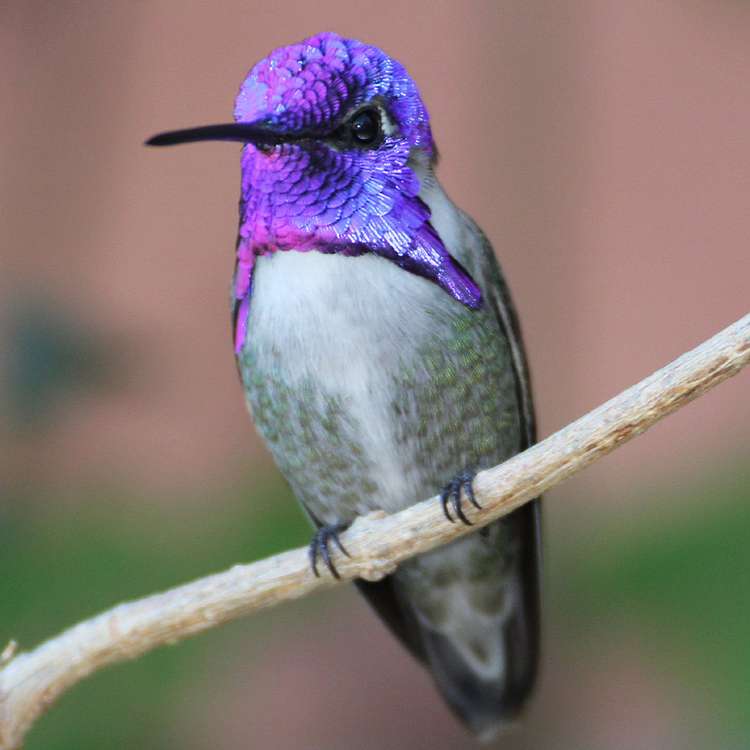
HUMMINGBIRD GARDEN
This garden is planted with salvia, desert honeysuckle, desert willow, and many other hummingbird-friendly plants. Hummingbirds are drawn to sweet, flute-shaped flowers, which are perfect for the birds’ long, narrow beaks. You’re sure to see a “hummer” flitting from flower to flower. The hummingbirds most frequently seen in this garden are the black-chinned, a summer visitor, and the Costa’s and Anna’s, which have taken up permanent residence in the gardens. Migrants you may see include broad-billed, rufous, and occasionally calliopes and Allen’s. These hummingbirds, which migrate from colder climates, may be seen drinking their fill from the salvia, which blooms through the winter season.
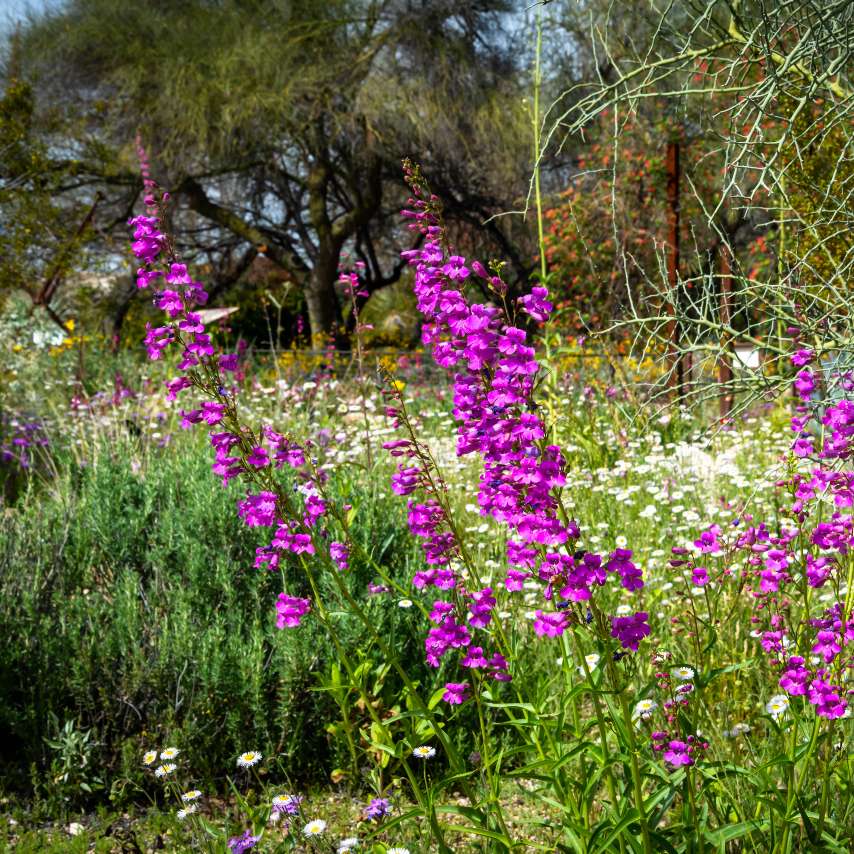
PENSTEMON GARDEN
Penstemons, sometimes called beardtongue, are a favorite of gardeners. Its 275 species were widely cultivated on both sides of the Atlantic ever since scientists first described them in 1748.
In the Sonoran Desert, native penstemons are also the favorite of hummingbirds and have evolved to appeal to their sensibilities. Long, tubular flowers are made to fit a hummingbird’s long beak and tongue, and coincidentally, the flowers come in a range of hummingbird-approved colors- just so long as it is red! As proponents of drought-tolerant and wildlife-friendly landscaping, we have dedicated an entire garden to one of the most visually and environmentally appealing genera viable in the Sonoran Desert, the Penstemon. Learn more here.

DESERT PALM OASIS
The Desert Palm Oasis, brings to light the Sonoran Desert’s tropical connection in a unique biome interpretation not found anywhere else. Several species of native palms (brahea, sabal and Washingtonia) usually found in isolated oases in narrow canyons along the coast of the Sea of Cortez near Guaymas, Mexico are being placed in an accessible walking garden that incorporates other native plants of the canyons such as rock fig, sea grape, and Nacapule jasmine, along with a “spring-fed” stream that will support a population of endangered native fish. For more information click here.
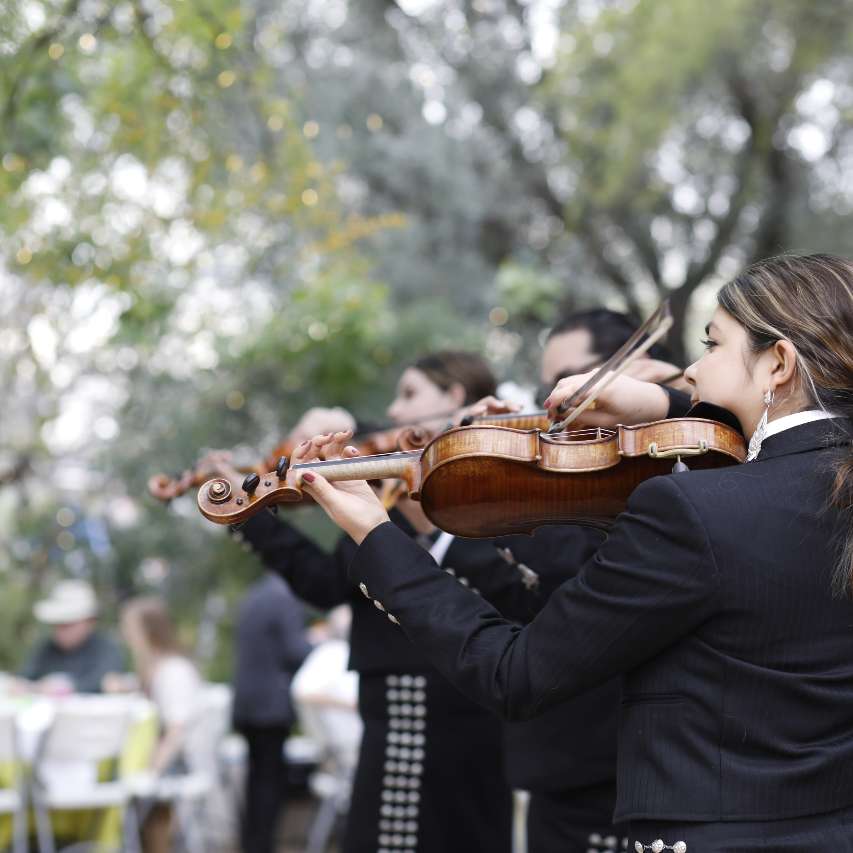
Alice Y. Holsclaw
PERFORMANCE GARDEN
Tohono Chul’s Performance Garden sits beneath a grove of mature sweet acacia trees. Concerts, special events, and lectures are presented in this garden. In addition to being a cool respite from the heat of summer, the Performance Garden imparts a lush atmosphere of flowers, trees and songbirds for many weddings.

Bank of America
CHILDREN’S GARDEN
This garden was built especially for children, capturing the imagination and providing opportunities for creative learning and discovery. Children are encouraged to explore the natural world on their own and adults are invited to incorporate some of the ideas presented here into their home gardens. We hope our youthful visitors enjoy the private spaces and hidden surprises. Children of all ages can float wooden “fish” boats down the painted and tiled stream, play the xylophone wind chimes and listen to a story while seated on the rattlesnake wall.
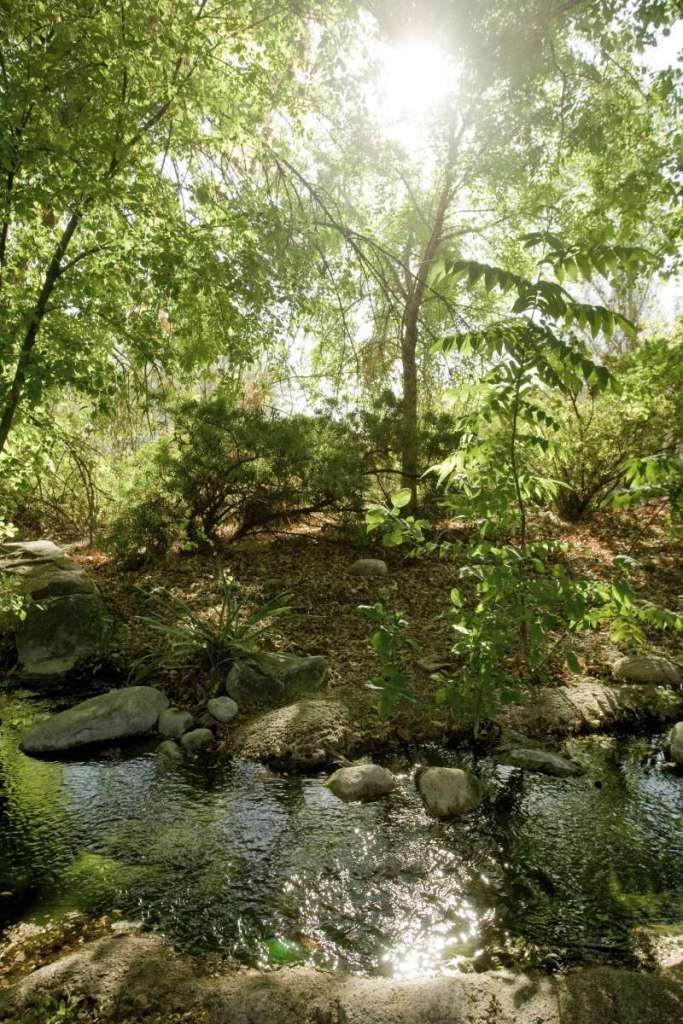
Barbara Kennard Present
Streamside Garden
The Streamside Garden presents many ideas for creating a desert oasis at your home using native plants. The soothing sounds of flowing water are everywhere in the gardens and endangered species of native fish (topminnow & desert pupfish) live safely in both the re-circulating stream and the grotto under the stairs. Plants found near perennial streams around Tucson are featured in this section. Don’t miss the Geology Wall. Here you can see and touch how the nearby Santa Catalina Mountains were formed. The Desert Tortoise habitat is also located in this area. Two tortoises and several whiptail and desert spiny lizards live year-round in the small habitat. This charming garden is another favored site for brides-to-be planning a small, intimate, outdoor wedding.
Tohono Chul’s Riparian Habitat is a re-creation of the once abundant perennial streams of southern Arizona, in particular what you might find in Sycamore Canyon, 50 miles south in the Atascosa Mountains (4000ft.). Riparian habitats are diverse associations of plants and animals that live on the banks of rivers and streams. The extraordinary importance of these habitats to native wildlife has caught the public’s attention in recent years. For example, it is estimated that roughly half of all breeding birds in the deserts and grasslands of the Southwest nest exclusively in riparian habitats. Given the number of species dependent on these areas, it is astonishing to note that riparian communities cover much less than one percent of the region’s total landmass!
For more information about creating your own desert oasis, click on the links below:
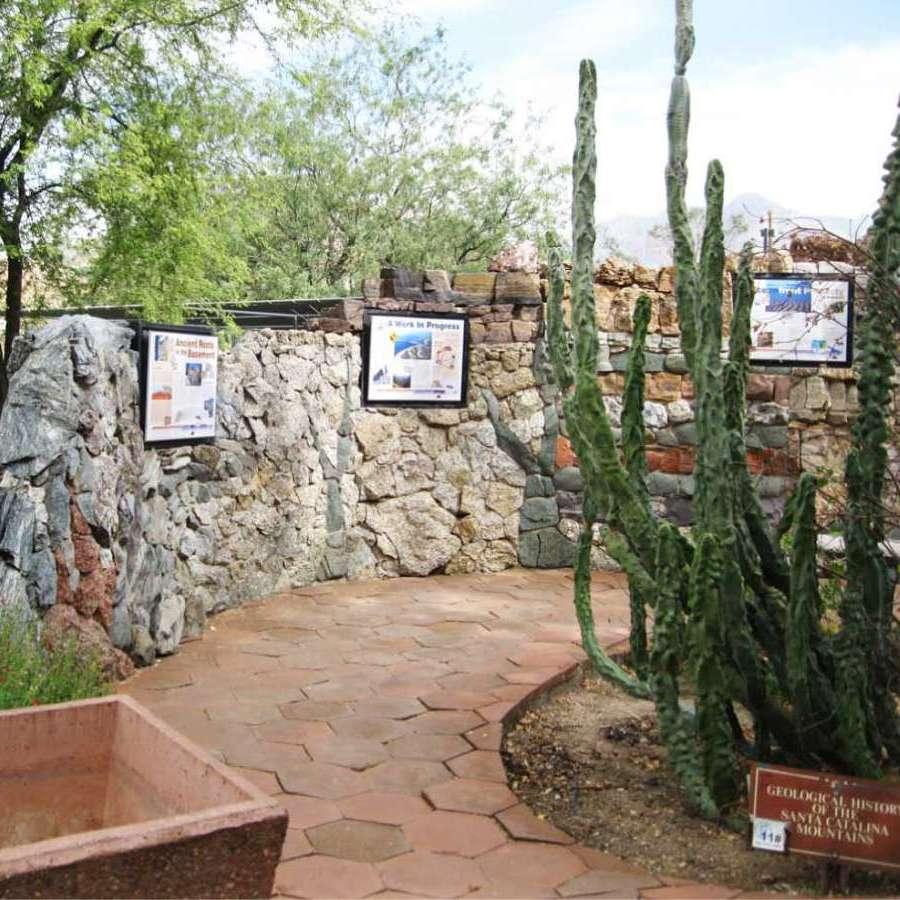
GEOLOGY WALL
Unique in all of Tucson, if not the world, is Tohono Chul’s Geology Wall exhibit. The idea of founder Richard Wilson, a geology professor with the University of Arizona, and built by geologist Doug Shakel and Toby Wright, the 55 foot long, semi-circular wall consists of several hundred rock specimens that represent the more than two dozen geologic formations that comprise the 9,000-foot Santa Catalina Mountains, visible just over the top of the wall itself. As you proceed along the Wall from left to right, you are walking through nearly two billion years of the Earth’s history! In general, the rocks of the Catalinas (and the Wall) become younger and younger as you proceed southward. Thus Tucson is built on the youngest rocks, displayed on the far right. The oldest are displayed on the far left and would be found north of Tucson near the town of Oracle.
Learn more about the geology of the Santa Catalina Mountains with the help of illustrations by Cartoonist David Fitzsimmons? Click here
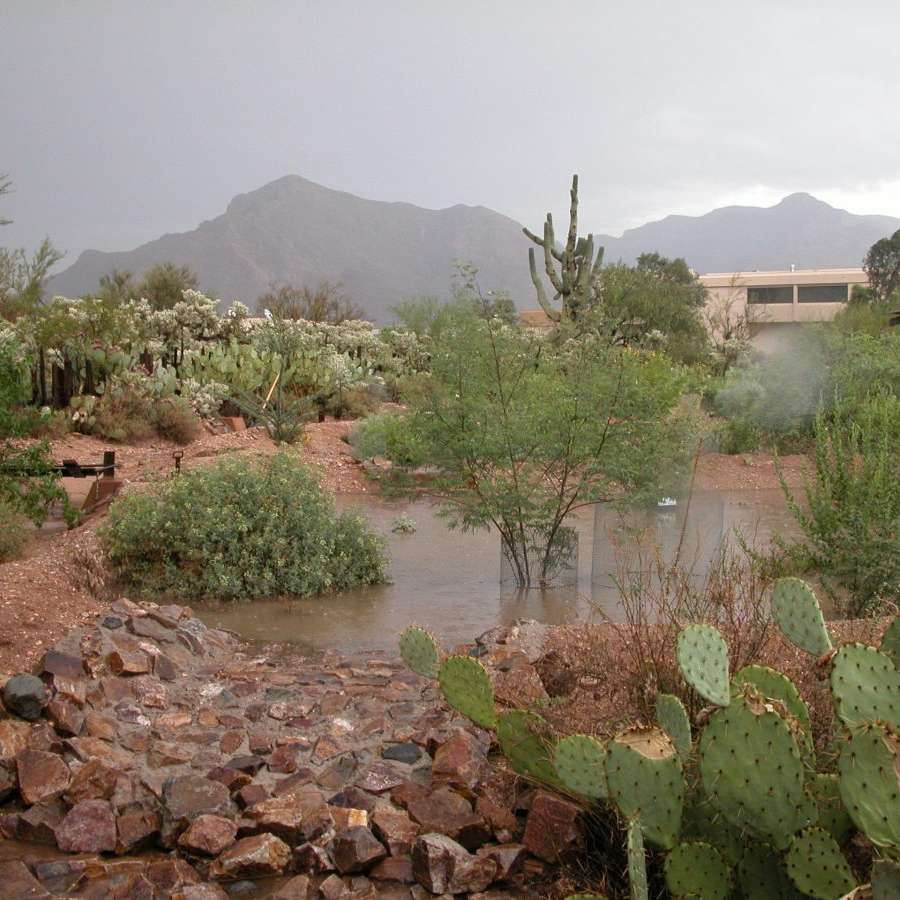
SIN AGUA GARDEN
“Sin Agua” means “without water” in Spanish. Hence, this garden features desert landscaping using mostly harvested rainwater. Any homeowner can adapt the landscape concepts demonstrated in this garden to their own landscape. Demonstrations include water harvesting, control and use of runoff, as well as testing native plants for adaptability under the rather challenging conditions of alternating flooding and drought. The plantings are dominated by native shrubs and ephemerals, with scattered small trees. This garden is at its blooming peak following summer rains, and in the spring following moist winters.
Want to learn more about designing a garden or planting crops with only the rain the desert provides? Have a look at our interpretive signage:
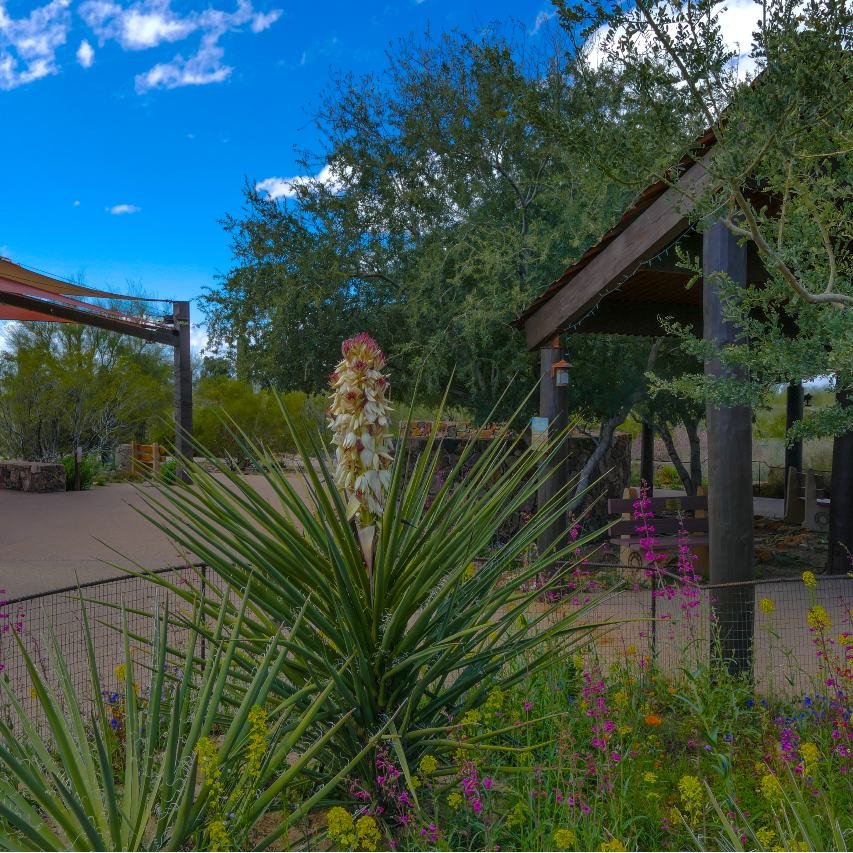
The Barmann
SONORAN SEASONS GARDEN
Located in the “heart of the gardens,” opposite the Overlook, is the Sonoran Seasons Garden. The space reflects the seasonal variations of the Arizona Upland. Amazingly, this subdivision of the Sonoran Desert actually boasts five seasons – winter, spring, dry summer, monsoon summer, and fall!
Each of the five sub-gardens spotlight the seasonal adaptations of native plants active during that time of year. Throughout the Garden are plantings of ironwood, desert willow and ocotillo. A tin-roofed ramada provides shade for visitors and an intriguing cactus courtyard provides a new entry to Tohono Chul itself. The Sonoran Seasons Garden is also a comfortable destination for those with limited time or mobility, allowing visitors to experience the essence of Tohono Chul just a short walk from Admissions.
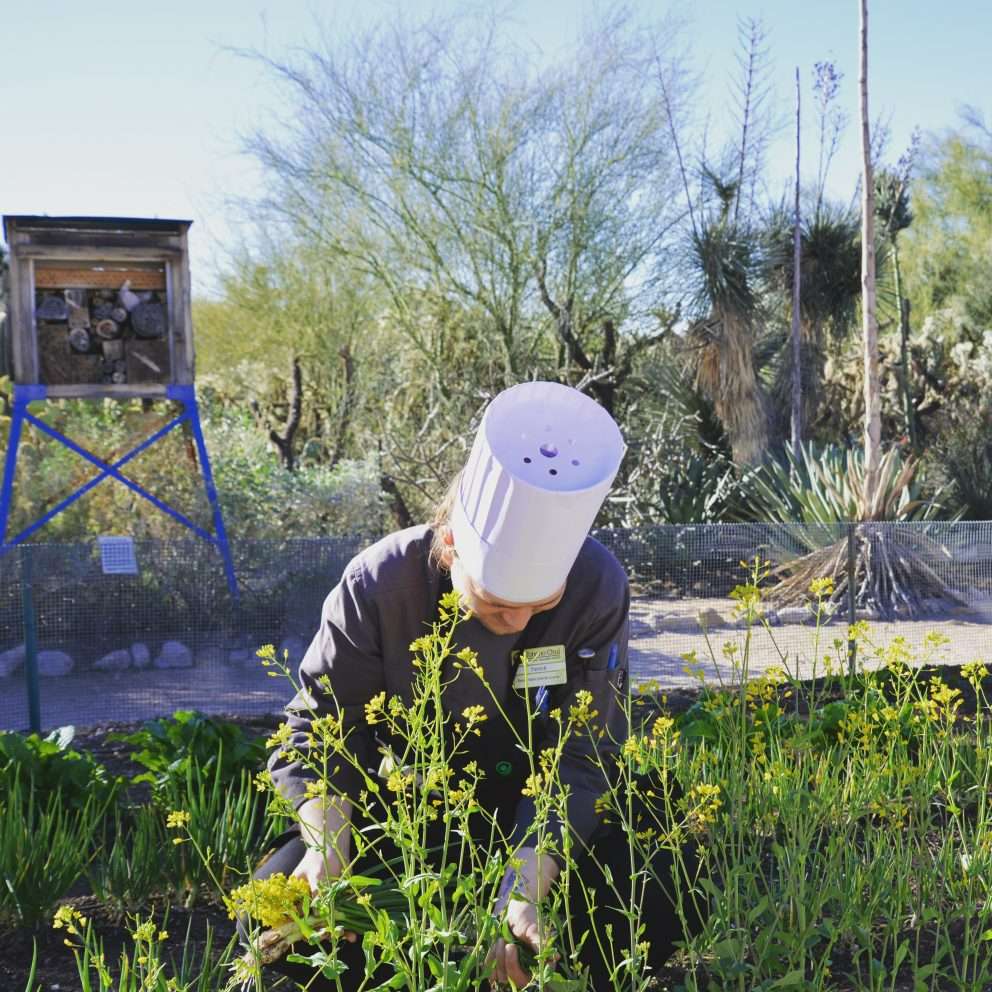
ETHNOBOTANICAL GARDEN
The Tohono O’odham and the Spanish foraged and flood-farmed this land for many years. The Ethnobotanical Garden displays the types of plants they used for food, basket making, medicine, and cultural ceremonies. The summer garden features native plants flood farmed by the Tohono O’odham, as well as indigenous plants they harvested for their fruit, seeds, and fibers. The winter crop features plants the Spanish and other Europeans brought with them to the New World. These crops helped to bring the Tohono O’odham to the missions to live, because they were a guaranteed food source during the time of year that food was scarce.
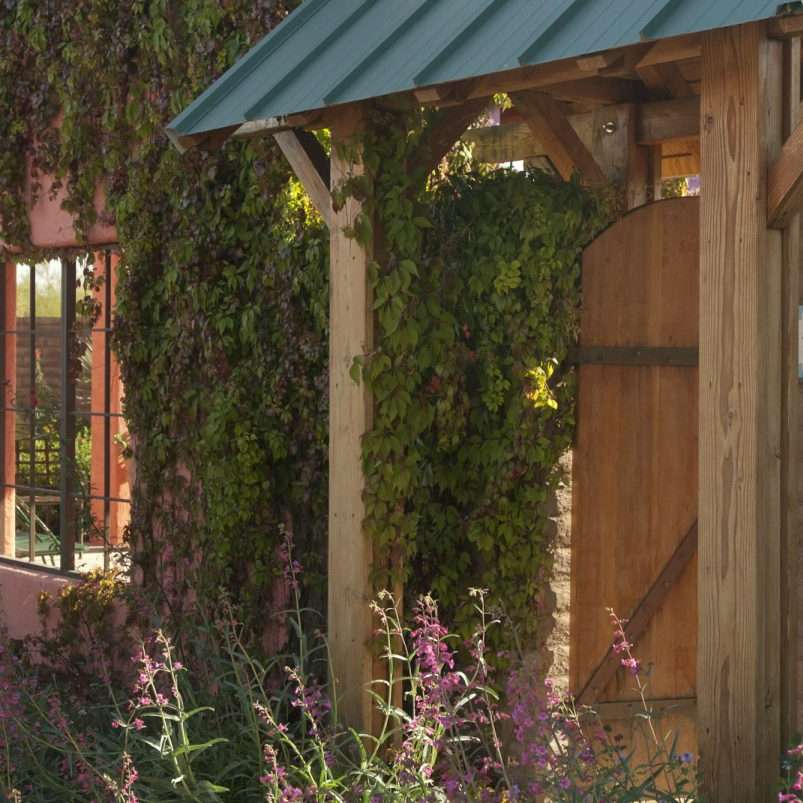
Cargill and Bradley Families
DESERT LIVING COURTYARD
The Cargill and Bradley Families Desert Living Courtyard is divided into ten distinct garden vignettes, featuring a variety of landscape themes, each designed to demonstrate for homeowners new and creative ideas for using water-conserving plants in livable landscapes combining color, texture, and function. Want to learn more about “gardening where we live?”. To find out more about the Desert Living Courtyard please click here.
Complete Plant List of Desert Living Courtyard, Ranked by Water Usage
Barrio Garden Layout and Plant List– peek behind the walls of one of Tucson’s traditional barrio gardens filled with bright colors, rusticated, recycled materials, and unique containers
Container Garden Layout and Plant List – for the homeowner with limited space, containers provide many alternatives to in-ground plantings, including a “potted” water feature
Moorish Garden Layout and Plant List – reflecting the sensual tranquility of a shaded Moorish-inspired garden laid out around a cooling fountain in colors of blue, white, and yellow
Xeriscape Garden Layout and Plant List – a demonstration of the classic principles of Xeriscape design clearly defining the “zone” concept and blending into the surrounding landscapes
Wildlife Garden Layout and Plant List – this boulder-strewn desert landscape features a shallow “natural” pond. Plants are selected for minimal water use and attractiveness to small wildlife
Dry Shade Garden Layout and Plant List – for those gardens with less than abundant sunshine, the spotlight here is on native and arid-adapted plants that thrive in partial or total shade
Winter/Summer Garden Layout and Plant List – garden beds filled with plants that bloom in either of Tucson’s most extreme seasons – the cold of winter or the heat of summer
Meditation Garden Layout and Plant List – inspired by the simplicity of a Zen garden, this smallest of the ten vignettes demonstrates that even a tiny space can become a peaceful refuge with carefully chosen plant material and hardscape symbolizing the natural environment
Outdoor Living Garden Layout and Plant List – here architecture and plants combine to create a sense of place that is informal, comfortable, adapted to our desert surroundings, and inviting for year-round outdoor family living
Utility Garden Layout and Plant List– a practical demonstration of gardening basics from tool storage and potting benches, to composting and low tech water harvesting, including a kitchen garden in a cattle tank
